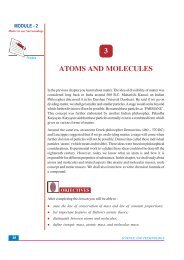Audio and Video programmes - The National Institute of Open ...
Audio and Video programmes - The National Institute of Open ...
Audio and Video programmes - The National Institute of Open ...
Create successful ePaper yourself
Turn your PDF publications into a flip-book with our unique Google optimized e-Paper software.
Prog. Duration <strong>of</strong> Minutes<br />
Code Title Language in Hindi in English<br />
211/V-16 Volume <strong>and</strong> Surface Area Hindi <strong>and</strong> English 14.50 14.40<br />
This programme deals with the application <strong>of</strong> formulae to find out volume <strong>and</strong> surface area <strong>of</strong> solids <strong>of</strong><br />
different sizes <strong>and</strong> shapes in our daily life. <strong>The</strong> uses <strong>of</strong> these concepts in our daily life have been presented<br />
through computer graphics <strong>and</strong> group activities. This programme also shows why a cube <strong>of</strong> side 1 cm is<br />
used as the st<strong>and</strong>ard unit for measuring volume.<br />
211/V-17 Pythagoras <strong>The</strong>orem Hindi <strong>and</strong> English 12.20 12.40<br />
This programme deals with a very interesting property <strong>of</strong> a right-angled triangle <strong>and</strong> highlights the contribution<br />
<strong>of</strong> Pythagoras in this regard. With the help <strong>of</strong> this property, the methods <strong>of</strong> finding the height <strong>of</strong> mountain<br />
peaks <strong>and</strong> distances between stars <strong>and</strong> their sizes have been explained. <strong>The</strong> use <strong>of</strong> this property has been<br />
shown with the help <strong>of</strong> some examples.<br />
211/V-18 Statistics Hindi <strong>and</strong> English 17.30 16.40<br />
In this programme, the methods <strong>of</strong> collecting information <strong>and</strong> their importance have been highlighted.<br />
This programme shows various ways in which we can process data to get the much desired<br />
information. <strong>The</strong> terminology <strong>and</strong> special features <strong>of</strong> the study <strong>of</strong> Statistics are also covered in a dramatization<br />
format.<br />
211/V-19 Height <strong>and</strong> Distance Hindi <strong>and</strong> English 13.50 13.55<br />
In this programme, the methods <strong>of</strong> finding values <strong>of</strong> T-Ratios for angles <strong>and</strong> their use to find unknown<br />
heights <strong>and</strong> distances have been described. This programme also shows how “Scientific Computer” is<br />
used for finding these values. It also shows how to use Clinometers to measure an angle. <strong>The</strong> angles <strong>of</strong><br />
depression <strong>and</strong> elevation have also been explained through various examples using animated figures.<br />
211/V-20 Trigonometry- An Introduction Hindi <strong>and</strong> English 15.50 16.25<br />
This programme deals with application <strong>of</strong> Pythagoras theorem <strong>and</strong> other properties <strong>of</strong> a triangle in our<br />
day-to-day life. Its applications have been demonstrated by taking some common examples like finding<br />
the height <strong>of</strong> a pole without climbing on it. <strong>The</strong> ratios <strong>and</strong> the relations between the sides <strong>and</strong> angles <strong>of</strong> right<br />
angle triangle have been shown with the help <strong>of</strong> computer graphics. A few trigonometric identities have also<br />
been covered in the programme.<br />
Science <strong>and</strong> Technology (212)<br />
212/V-1 Pendulum Hindi <strong>and</strong> English 14.56 15.45<br />
<strong>The</strong> programme starts with a number <strong>of</strong> examples <strong>of</strong> oscillatory motion in our daily life. It describes some<br />
experiments performed with the help <strong>of</strong> a pendulum. <strong>The</strong> first experiment is to find the time period <strong>of</strong><br />
different amplitudes. In the second experiment, the time period has been computed for different lengths <strong>of</strong><br />
the pendulum. <strong>The</strong> programme concludes with the findings <strong>of</strong> these experiments, emphasizing the need <strong>of</strong><br />
the exact <strong>and</strong> accurate measurement.<br />
22

















